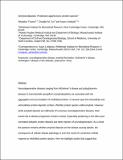Amyloid Deposits: Protection Against Toxic Protein Species?
Author(s)
Treusch, Sebastian; Cyr, Douglas M.; Lindquist, Susan
Downloadmain article (1.493Mb)
OPEN_ACCESS_POLICY
Open Access Policy
Creative Commons Attribution-Noncommercial-Share Alike
Terms of use
Metadata
Show full item recordAbstract
Neurodegenerative diseases ranging from Alzheimer’s disease and polyglutamine diseases to transmissible spongiform encephalopathies are associated with the aggregation and accumulation of misfolded proteins. In several cases the intracellular and extracellular protein deposits contain a fibrillar protein species called amyloid. However while amyloid deposits are hallmarks of numerous neurodegenerative diseases, their actual role in disease progression remains unclear. Especially perplexing is the often poor correlation between protein deposits and other markers of neurodegeneration. As a result the question remains whether amyloid deposits are the disease causing species, the consequence of cellular disease pathology or even the result of a protective cellular response to misfolded protein species. Here we highlight studies that suggest that accumulation and sequestration of misfolded protein in amyloid inclusion bodies and plaques can serve a protective function. Furthermore, we discuss how exceeding the cellular capacity for protective deposition of misfolded proteins may contribute to the formation of toxic protein species.
Date issued
2009-06Department
Massachusetts Institute of Technology. Department of BiologyJournal
Cell Cycle
Publisher
Landes Bioscience
Citation
Treusch, Sebastian, Douglas M. Cyr, Douglas M., and Susan Lindquist. "Amyloid Deposits: Protection Against Toxic Protein Species?" Cell Cycle 8.11 (2009): 1668-1674.
Version: Author's final manuscript
ISSN
1551-4005
1538-4101